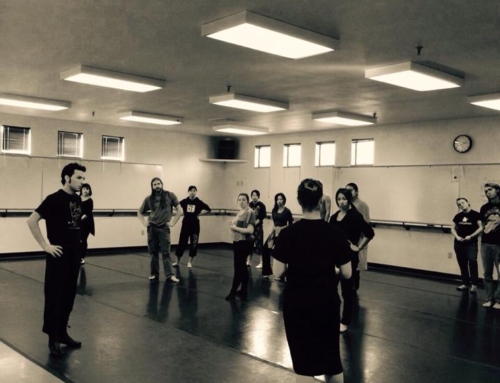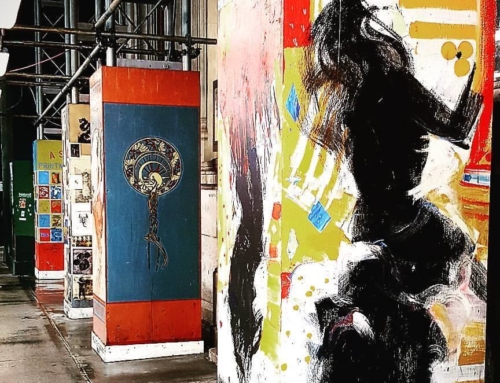I started to write a blog post about money….yes, I know, it’s taboo to talk about money. But when people ask me what I do, and I say I dance, the next question is often, “And you can actually make a living doing that?” The simple answer is yes. Heck yes–it’s the best living I could ever imagine because I get to do what I love every day and I work with amazing colleagues equally passionate about what they do.
Then I asked myself—do I really want people to know that even though I’m “making it” as an artist, life isn’t all peaches and cream? So much of being an artist is about selling an image, is it ok if people know that it’s not all glamour? My answer is yes, we should be honest about money in the arts (or lack thereof).
| Found this on Facebook the other day; I think it’s brilliant! |
As I started jotting down how I budget, how dancers deal with money during injuries, and reading articles about dance and money, I realized dancers, in many ways live outside of social norms (We want to create more than we want the white picket fence an a car in the driveway…), but to really make it work, we’ve got to live within social norms too. The former makes some people with salaries not even begin to understand how dance works as a job, much less a career. So yes, we are a little crazy.
And I’m totally okay with that. I’m totally okay being looked at as crazy. I’ve heard it many times from many people–“I wish I would have had the courage to do what you’re doing.” I don’t think of it as taking a great deal of courage to do what I love because my love for dance is too great for me to have seen any other option.
I always wonder, how would the world be a different place if everyone pursued their passion—cared more about finding and pursuing what they loved, and less about finding stability, wealth, or having that picture perfect “success”?
The dancer’s life is not easy, particularly when it comes to finances. As one writer put it, we “live “close to the bone.” That edge you see in her dance? Her steel is real.” (Lightsey Darst, The Huffington Post). Much of the money we make is put right back in to our dancing; dance classes, dance shoes, pilates classes, massages, dance costumes…Yes, part of me lives in a fantasy–I am living my dream, but part of me has to be grounded in reality to make that dream work. That’s one difference between a starving artist and success…
So here’s a bit of that grounded-ness that balances our life in the clouds…
Injury:
Our instrument is our body; we have to take good care of it. And unlike professional athletes, most dancers are their own massage therapists and physical therapists. Sometimes injury and burnout occur despite the best of intentions. When an injury first happens, as dancers we often try to dance on it–if we dance on it too long, we’ll be majorly losing by doing permanent damage to our bodies. So the smart thing to do is to take a break, and unfortunately, chances are there is another dancer eager to take your place. In the mean time, we have to find another way to make money–part time administrative work, temp positions, etc. We dancers are quite resourceful, and always helping each other out–if you know of a job and know someone who needs work (often through Facebook), you let them know.
Budget:
I’m pretty sure a dancer as president would have no problem whatsoever balancing the budget. Let’s be honest, most dancers do not make a ton of money, except maybe for principle dancers in major companies like New York City Ballet and ABT. Even “big name” contemporary dance companies do not pay big bucks–you won’t be a millionaire even if you’ve “made it” as a dancer, and many of us are freelancers, which means we cannot depend on a steady monthly income. So that puts importance on planning ahead, not spending excessively, and putting money aside for when work is sparse or in case of emergencies. Here in NYC, I generally don’t eat out or take cabs–I pack a lunch every day and basically avoid cabs except when absolutely necessary (like a 5am ride to the airport). If you want to live a luxurious life, dance is not for you, unless you have other means of support.
Creating opportunity:
If work is not finding you, then you create opportunities to work. It’s that simple. To be an artist, it helps to have a business mind. That’s a hard balance. For example, the first time I put on my own show, I did almost everything myself, from designing the poster to the online ticketing, organizing the finances, sending out press releases, etc., so by the time I hit the stage, I was exhausted and distracted by that work—would I sell enough tickets? Was everything okay in the front of house? I did not enjoy myself because the business side had me stressed. Producing a show is hard work, so finding a balance between business and art is delicate.
Investing:
Not investing in the stock market (though opening a retirement account is a good idea). Investing in you. Taking classes, networking, seeing shows—that’s all part of investing in your career. Someone might see you in class and love the way you dance and hire you for a gig—then that $20 dollars you paid for class becomes more than just an investment in bettering your dancing, but an investment in your career. Also investing time studying and improving, so when people see you dance, you have something to show.
Grant money:
We need the arts, and luckily there are many organizations, including the government, that support the arts monetarily. Not nearly enough, but it’s out there.
Saving:
Someone recently asked me how I’ve saved money to go to Spain—my answer; I don’t really spend money on things—it’s pretty simple. I.e., I don’t buy things I don’t need; my priority is spending money to be a better dancer, be it classes, dance shoes, a costume, etc. (I’m also young and not responsible for any other human beings—no kids and no one else I need to support).
If you must, get a part time job, or a full time job. There’s no shame in that. (But hopefully a job that does not consume all your energy and stress you out. Dancing requires a lot more time than people imagine; we may only be on stage for a couple hours, but there’s countless hours that go behind each hour that is onstage. I recently had to get a part time job due to some large and unexpected expenses, and the worst part has been that I don’t have time to do my usual cross training and exercises outside the studio that keeps my body healthy and prevents injury. My hip started bothering me, so I cut back a little bit on the hours and made more of an effort, despite being drained at the end of the day, to do exercises that keep my body healthy.)
 |
| From a performance in LA at El Cid; I met some amazing artists very passionate about their art. |
Recently in my various travels, I’ve been to several artists’ houses. Some close friends and some near strangers, all flamencos at least 5 years my senior. None of these artists are living in shambles. Even dancers, having jobs in the poorest of the arts, can make a middle class living, and some even make more than that. Starting out is especially hard, but seeing that many other people make it work makes it a little less scary.
As I debate whether or not to publish this blog post, I reflect on the idea of writing about money, I realize that while writing, I felt like I have to defend my decision to be a dancer; that I have to prove to society that it’s okay. I shouldn’t have to do that—why do we value the arts so little that so many people are discouraged from the arts? We give so much importance to creativity through childhood, and then as adults we’re expected to have “serious jobs”—but being an artist is serious work. I think there are two things that really humanize us—expression through creative endeavors, and curiosity about the world.
For some interesting articles on dancers and money, check out this series of articles on the Huffington Post: http://www.huffingtonpost.com/lightsey-darst/dancer-income-wages-lifestyle-_b_1556794.html









The older I get, the more I know you need to pursue your dreams and the importance of art in all of our lives.
You came by my science ladybug site and I happened to look at the stats. My regular blog is http://www.annbennett2.blogspot.com
Take care,